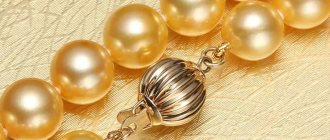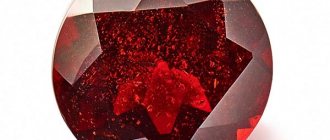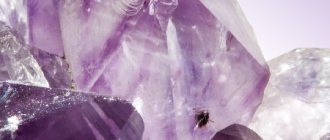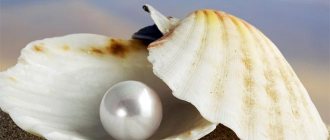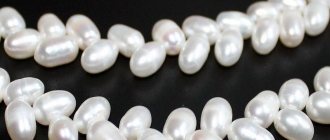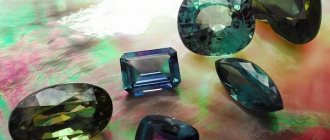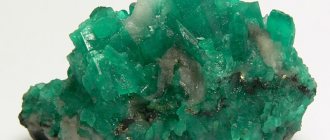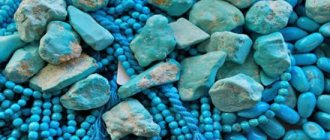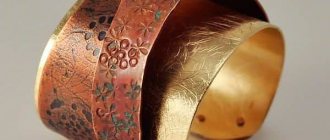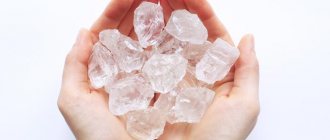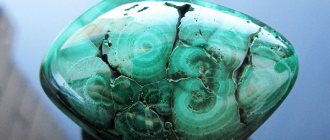| Stone type | Precious, semi-precious |
| Prevalence (Deposits) | Mexico, Panama, India, Tahiti, Sri Lanka, Japan, etc. |
| Varieties | Acoya, Baroque, Mabe, Mallorca, Oceanic, Freshwater, Tahiti, South Sea |
| Transparency | Translucent, opaque |
| Shine | Pearl |
| Mohs hardness scale | 3—4 |
| Chemical composition | CaCO3 |
| Color | White, blue, yellow, gold, pink, gray, black |
| Owner's color type | Spring, winter, autumn |
| Owner's temperament | Melancholic, Sanguine |
| Names | Andrey, Boris, Valentina, Galina, Eva, Evgeny, Evdokia, Inna, Irina, Claudia, Lilia, Margarita, Nadezhda, Oleg, Rosa, Sergey, Sofia, Elina, Yuliana |
| Zodiac sign | Libra, Cancer, Pisces |
| Date of Birth | from June 22 to July 22 from September 23 to October 23 from February 19 to March 20 |
| Chinese horoscope | Rabbit, horse, dog |
| Element | Water, Air |
| Planet | Neptune |
| Day of the week | Monday |
| Month | June, July, November, February |
| Season | Winter, summer, autumn |
| Numerology vibration | 2, 6, 7 |
| Chakra | Vishuddha, Sahasrara |
| What stones is it compatible with? | Aventurine, aquamarine, amethyst, turquoise, diamond, heliodor, heliotrope, garnet, emerald, moonstone, opal, rose quartz, ruby, chrysoprase, zircon, jasper |
| What stones is it not compatible with? | Beryl, malachite, sardonyx |
| Therapeutic effect (problems) | Blood pressure, vision, immunity, nervous disorders, memory and mental abilities |
| Therapeutic effect (on organs) | Organs of the gastrointestinal tract |
| Magic properties | Spiritual development, deception, strengthening relationships, black magic |
Pearls are the only precious mineral of animal origin in the world. Jewelry with it has been valued at all times. High and stable demand has led to the emergence of many imitations of this material. In order not to buy a fake, you need to know how to distinguish natural pearls from artificial ones.
Terminology: What are wild, cultured and cultured pearls?
There are several varieties of pearls. The well-known natural one is far from the only representative of this type of mineral. In addition to it, there are cultivated and artificial types.
Natural pearls can be divided into sea and river pearls. Natural “gift of the sea” is formed by the introduction of a grain of sand into the mantle of a bivalve mollusk. Over time, it becomes covered with a layer of mother-of-pearl. This process takes several years - this is what makes pearls such a valuable material.
Be sure to watch: All about freshwater pearls
The freshwater species is formed in exactly the same way, however, unlike the marine species, it has a less expressive shine and is not always an ideal shape. For this reason, its cost is much lower.
A cultivated mineral is created by man. The principle of its formation is the same. The only difference is the core of the pearl. It's artificial. The longer the pearl “matures,” the thicker the layer of nacre formed. With artificial cultivation, you can control not only the size, but also the shade of the mineral. Visually, cultured pearls are very difficult to distinguish from natural ones. The leader in this area is Japan, second place belongs to China.
Artificial pearls are also available in several types. The most famous is called “Mallorca” (after the place of production). This is an organic type of pearl that imitates the natural process of pearl formation. Today it is the best imitation of natural pearl mineral on the jewelry market.
Roman pearls, the ancestor of the artificial variety, are glass beads filled with paraffin and coated with pearl essence.
Shell pearl is an American invention consisting of a core and many layers of pearlescent varnish.
It would be a stretch to call plastic beads artificial pearls. However, it is under this name that they can be found on the shelves of jewelry stores.
Which pearls are better - sea or river pearls?
Freshwater river is grown in former rice fields in China. Farmers monitor water levels and also turn the pearls over so that they do not turn out “one-sided”. During the growing process, a person controls only the conditions for growth and the shape, but does not “grow” the nacre itself into balls and other materials.
Cultured freshwater pearls look brighter than sea pearls because they have a thicker layer of nacre. This phenomenon is associated with the introduced seed nucleus into mollusks.
Its colors, sizes and shapes are varied. In this regard, it is popular and in demand.
Freshwater is cheaper than seawater. During the cultivation process, 20-30 pearls can fit into its shell, but usually only one into a sea shell.
Akoya pearls are a "classic". Jewelry made from it is often found in jewelry stores. Most of it is grown and collected in Japan on the islands of Honshu and Kyushu, Ago Bay. It is also grown in Vietnam and China.
Akoya pearls are spherical in shape and have a diameter of 2-10 mm. In color it can be cream, silver, pink, pale yellow, with a green-black tint.
Basic verification methods
You can determine the authenticity of pearls at home using the following methods:
- visual;
- mechanical;
- chemical-physical;
- formal.
By combining these methods, confidence in the results can be significantly increased.
Visual inspection methods
Visual assessment includes examination of characteristics such as:
- color;
- form;
- structure;
- shine;
- weight.
How to distinguish natural pearls from artificial ones?
